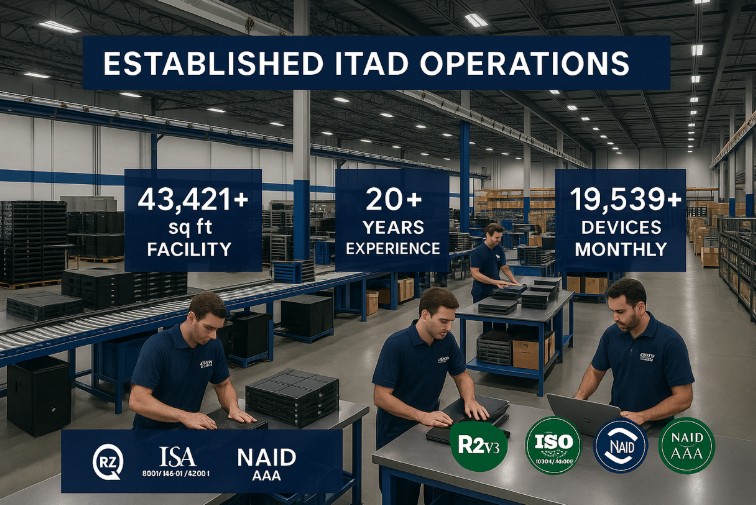When data breaches can cost millions and environmental compliance is tightening, effective IT asset disposal has become a critical business function. Yet many enterprises overlook the importance of a strategic IT Asset Disposition (ITAD) program.
From protecting sensitive data to managing electronic waste responsibly, the stakes for secure, compliant ITAD have never been higher.
Understanding IT Asset Disposition
In today’s fast-paced technology environment, companies face growing challenges managing aging and obsolete equipment. IT Asset Disposition refers to the secure, environmentally responsible handling, disposal, recycling, or resale of outdated IT assets.
A well-executed ITAD process:
- Prevents unauthorized data access through certified data destruction.
- Supports environmental sustainability and regulatory compliance.
- Recoups value through asset remarketing and parts recovery.
- Enhances brand reputation by demonstrating responsible lifecycle management.
Strategic ITAD not only minimizes legal and reputational risk it also positions companies as responsible leaders in secure, sustainable operations.
The Business Case for Responsible IT Asset Disposal
Understanding the importance of ITAD is essential to effective lifecycle planning. Key benefits include:
- Secure Asset Management: Ensures outdated IT equipment is tracked and decommissioned responsibly
- Data Protection: Safeguards sensitive information from unauthorized access through verified data destruction methods.
- Regulatory Compliance: Meets environmental and data privacy regulations (e.g., GDPR, HIPAA, EPA).
- Financial Return: Resale of retired assets helps recapture value and improve return on investment (ROI) on tech investments.
Key Benefits of ITAD for Enterprise Operations
Effective ITAD strategies go beyond basic asset disposal, they provide long-term strategic advantages for modern enterprises:
- Enhanced data security that prevents costly breaches and protects reputation
- Reduced environmental liability through responsible handling of hazardous materials and adherence to sustainability practices
- Improved compliance with international and regional standards, minimizing legal and financial exposure
- Financial recovery via asset remarketing, offering a cost-effective means of technology management
- Strengthened corporate responsibility and sustainability credentials, boosting brand perception among stakeholders
By embedding ITAD into enterprise lifecycle planning, organizations gain operational efficiency, risk reduction, and measurable returns.
Key Components of an Effective ITAD Program
Executing ITAD effectively requires multiple critical components, each ensuring thorough management of IT asset disposition. These elements collectively form a robust framework for managing outdated technology responsibly and sustainably.
Secure Data Destruction
Secure data destruction is essential for preventing data breaches, identity theft, and corporate espionage. Organizations must implement verified, auditable processes, including:
- Physical destruction (e.g., shredding, crushing) to render data irrecoverable.
- Digital data sanitization (e.g., software wiping, degaussing) to eliminate data thoroughly.
- Documentation and certification of destruction methods to maintain transparency and compliance.
Compliant Electronics Recycling
Working with certified recycling providers ensures hazardous materials are handled safely and in line with environmental regulations.
- Adherence to standards such as R2 (Responsible Recycling) supports quality, safety, and sustainability.
- Safe handling and recycling of hazardous electronic waste reduces environmental risk.
- Verified processes help businesses maintain compliance and avoid penalties and reputational damage.
Environmental Responsibility and E-Waste Reduction
Companies demonstrate environmental responsibility by adopting sustainable recycling practices and promoting ecological conservation. According to the World Health Organization (WHO), only about 17% of global e-waste is recycled responsibly—a figure that highlights the urgent need for sustainable disposal practices.
Sustainable ITAD practices include:
- Minimizing the ecological impacts of electronic waste through certified recycling processes.
- Recovering and reclaiming valuable materials (e.g., metals, plastics, lithium batteries) for reuse.
- Reducing landfill waste and contamination, aligning with corporate sustainability initiatives.
Legal and Regulatory Compliance
- Staying ahead of legal requirements is essential for reducing risk and ensuring operational continuity. Proactive compliance management protects your business and streamlines audits.
Navigating Regional Compliance Requirements
Different regions impose specific compliance requirements, which companies operating internationally must manage carefully:
- WEEE Directive in the European Union requires comprehensive recycling and asset tracking.
- EPA guidelines in the United States necessitate proper documentation and disposal processes.
- Routine audits and documentation protocols ensure ongoing compliance and readiness for regulatory reviews.
Partnering with Reliable ITAD Vendors
Partnering with trusted ITAD providers streamlines disposal processes, reduces internal burden, and enhances regulatory compliance. The right vendor can improve operational efficiency while supporting data security and sustainability goals.
Selecting the Right ITAD Vendor
Choosing the right partner involves evaluating whether their services align with your operational needs and regulatory requirements. Look for:
- Comprehensive service offerings that address data destruction, recycling, and asset remarketing.
- Proven industry expertise demonstrating reliability and effectiveness.
- Transparent reporting and verifiable documentation to ensure accountability and consistent performance.
Evaluating Vendor Credentials and Certifications
A credible ITAD vendor should possess and maintain certifications validating their adherence to industry standards:
- R2 certification for responsible recycling practices
- NAID AAA certification for secure data destruction protocols
- Licensed facilities for recycling and disposal to meet federal, state, and industry regulations
Maximizing Value Through Asset Remarketing and E-Waste Disposal
Strategic asset remarketing and e-waste management provide significant financial and environmental advantages, creating opportunities for sustainable profitability.
The Asset Remarketing Process
Asset remarketing extends device lifecycles and recovers financial value through refurbishment and resale:
- Certified data sanitization and functional testing prior to resale.
- Secure resale practices to protect company’s reputation and customer trust
- Reduced manufacturing demand for new equipment, supporting sustainability and resource conservation
Sustainable E-Waste Management Practices
Organizations can reduce environmental impact by embracing certified e-waste recycling processes:
- Recover valuable materials like lithium, precious metals, and plastics.
- Divert waste from landfills, reducing contamination and long-term ecological impact
- Reinforce environmental responsibility, strengthening corporate ESG positioning
Comprehensive Asset Tracking and Secure Logistics
Accurate tracking and secure transportation logistics are foundational to a successful ITAD program, reducing risk, maintaining compliance, and improving transparency across the asset disposition process.
The Importance of Accurate Asset Tracking
Effective asset tracking ensures that every asset is accounted for throughout its lifecycle. Methods include:
- RFID tagging for real-time asset visibility
- Digital chain-of-custody systems for audit-ready documentation
- End-to-end transparency that supports security and compliance
Best Practices for Secure Transportation
Secure logistics are critical for protecting sensitive assets in transit. Best practices include:
- GPS-tracked vehicles to monitor movement and reduce theft risk
- Secure packaging to protect hardware during transport
- Partnership with vetted logistics providers who understand compliance and handling standards
Revenue Potential Through Refurbishment and Resale
Asset refurbishment and resale help organizations recover value and reduce waste, supporting both financial and environmental goals.
Opportunities for Refurbished Asset Revenue
Remarketed devices can create revenue streams by:
- Serving secondary markets.
- Meeting demands for cost-effective technology solutions.
- Extending the lifecycle of devices to support sustainability.
Market Trends Driving Resale Value
The growing demand for refurbished equipment is driven by:
- Rising environmental awareness.
- Economic pressures are driving demand for affordable tech.
- Enhanced corporate sustainability objectives.
Strategies for Optimizing Cost and Corporate Responsibility
Balancing cost efficiency with ethical, compliant disposal practices is essential to modern ITAD strategy.
Balancing Cost-Effectiveness and Ethical Practices
Strategic ITAD management of disposal processes allows companies to:
- Minimize costs without compromising security or sustainability.
- Adhere to ethical disposal standards, including verified recycling and data destruction.
- Protect brand integrity through transparency and responsible practices.
Measuring ITAD’s Impact on Corporate Responsibility
Track success by evaluating:
- Landfill diversion rates and material recovery.
- Revenue generated from asset remarketing.
- Audit outcomes and compliance reports.
A Holistic Approach to IT Lifecycle Management
Integrating ITAD into broader lifecycle planning supports long-term sustainability, cost control, and risk management.
Integrating ITAD into IT Lifecycle Planning
Organizations should include ITAD planning from the moment of asset procurement. This ensures:
- Streamlined decommissioning and recovery processes
- Continuous compliance across jurisdictions
- Smarter resource allocation and reduced e-waste
How Comprehensive ITAD Enhances Security and Sustainability
A holistic ITAD approach addresses critical business needs:
- Close security gaps associated with outdated or unmanaged assets
- Reinforces regulatory adherence through verified documentation
- Demonstrates environmental stewardship aligned with sustainability objectives
Why ITAD Is a Strategic Imperative for Modern Enterprises
In today’s compliance-driven, sustainability-focused landscape, IT asset disposition is no longer a back-office process. It’s a strategic pillar of IT operations.
When approached holistically, ITAD empowers organizations to:
- Protect sensitive data and ensure regulatory compliance
- Recapture value from retired equipment
- Advance corporate ESG and sustainability goals
By embedding ITAD into lifecycle planning, enterprises gain more than operational efficiency—they build resilience, reduce risk, and demonstrate accountability to customers, regulators, and stakeholders.
Explore how OEMSource supports secure, compliant, and sustainable IT asset disposition.
Frequently Asked Questions
How do you get rid of old IT equipment?
Proper disposal of old IT equipment requires partnering with certified ITAD vendors that offer secure data destruction services and comply with recycling regulations, ensuring both data protection and environmental compliance.
How do you handle the disposal of IT assets?
Proper handling of IT asset disposal includes using certified disposal processes, employing secure logistics, and utilizing robust asset tracking methods. These steps ensure regulatory compliance and minimize potential risks.
How do you properly dispose of IT equipment?
Proper disposal of IT equipment involves selecting licensed recycling service providers, conducting thorough data sanitization, and maintaining detailed documentation to fulfill regulatory obligations and ensure data security.
What is the difference between IT asset disposal and disposition?
IT asset disposal refers specifically to the physical removal of equipment, whereas IT asset disposition encompasses broader, comprehensive processes including data destruction, recycling, asset remarketing, and ensuring regulatory compliance throughout the asset lifecycle.
Why is IT asset disposition important for enterprise compliance and sustainability?
ITAD ensures that data is securely destroyed, equipment is properly tracked, and electronic waste is responsibly recycled. These practices help enterprises avoid regulatory penalties, reduce environmental impact, and meet internal ESG and sustainability goals.





